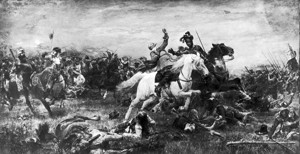Keine |
Destruction and annihilation
.JPG.aspx) Destructions by fire often were a result of the wars that Sankt Vith had been plagued with until the most recent past.
Destructions by fire often were a result of the wars that Sankt Vith had been plagued with until the most recent past.
Duke Wilhelm of Jülich, an ally of the French King, burned down the city in 1543. The Luxembourgian land, that was part of the Spanish Netherlands, as well as the area around Sankt Vith, were plagued by fires and murdering gangs in the 16th and 17th century.
The city chronicles of Sankt Vith mention a raid by Philip of Nassau who, on the night of the 17th of January 1593, tried to enter the city through a gate that was left open, using 1200 horsemen and 500 foot soldiers. Because of the restrained manner of a priest, named Philip Viltz, this attempt was aborted. Nine years later (1602) the Dutch forces under the supervision of Ludwig of Nassau, again appeared in front of the tower of Sankt Vith and threatened with total destruction of the city when a ransom was not paid. The people of Sankt Vith paid the ransom and avoided with this act that, after the destruction of the city, it would also be burned to the ground.
In the course of the Three-Year War, Sankt Vith was attacked and looted in 1632 by Dutch troops. In addition, the Black Plague costed many citizens of Sankt Vith as well as the surrounding area, their lives.
The peace of Westfalen (1648) that ended the Three-Year War, however, still brought no peace.
The French King, Louis the 14th, invaded the Spanish Netherlands several times. In 1675 Sankt Vith was looted by French troops, money sums were extorted and wealthy citizens were taken hostage.
In 1684 France managed to establish its rule over the Duchy of Luxembourg, after the surrender of the Luxembourgian settlement to the garrison.
The year 1689 was, like the year 1944, a year of destruction of the city.
In the war against the German Empire and the Netherlands, Louis the 14th ordered to destroy all settlements on the borders of the enemy territories. The settlement of Sankt Vith thus fell prey to his politics of ‘the scorched earth’ that took place in March.
The complete annihilation continued around the 5th of September when the city was turned to ruins and ashes by ‘French murderous gangs’.
The rebuilding was still on its way or almost finished when a new catastrophe destroyed the city a year later: a ruthless city fire destroyed the newly built houses and brought the citizens once again to a state of emergency.
During the course of the Spanish War of Succession (1702), Sankt Vith was attacked by German Hussars and looted. In the Peace of Utrecht (1713) the Spanish War of Succession was decided and the Duchy of Luxembourg, that was once again occupied by French soldiers, was added to Austria.